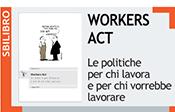Ultimi link in questa sezione
Come i redditi al top hanno raddoppiato la loro fetta di torta
WASHINGTON — The top 1 percent of earners more than doubled their share of the nation’s income over the last three decades, the Congressional Budget Office said Tuesday, in a new report likely to figure prominently in the escalating political fight over how to revive the economy, create jobs and lower the federal debt.
Enlarge This Image In addition, the report said, government policy has become less redistributive since the late 1970s, doing less to reduce the concentration of income.
“The equalizing effect of federal taxes was smaller” in 2007 than in 1979, as “the composition of federal revenues shifted away from progressive income taxes to less-progressive payroll taxes,” the budget office said.
Also, it said, federal benefit payments are doing less to even out the distribution of income, as a growing share of benefits, like Social Security, goes to older Americans, regardless of their income.
The report, requested several years ago, was issued as lawmakers tussle over how to reduce unemployment, a joint committee of Congress weighs changes in the tax code and protesters around the country rail against disparities in income between rich and poor.
In its report, the budget office found that from 1979 to 2007, average inflation-adjusted after-tax income grew by 275 percent for the 1 percent of the population with the highest income. For others in the top 20 percent of the population, average real after-tax household income grew by 65 percent.
By contrast, the budget office said, for the poorest fifth of the population, average real after-tax household income rose 18 percent.
And for the three-fifths of people in the middle of the income scale, the growth in such household income was just under 40 percent.
The findings, based on a rigorous analysis of data from the Internal Revenue Service and the Census Bureau, are generally consistent with studies by some private researchers and academic economists. But because they carry the imprimatur of the nonpartisan budget office, they are likely to have a major impact on the debate in Congress over the fairness of federal tax and spending policies.
Also cited as factors contributing to the rapid growth of income at the top were the structure of executive compensation; high salaries for some “superstars” in sports and the arts; the increasing size of the financial services industry; and the growing role of capital gains, which go disproportionately to higher-income households.
The report found that higher-income households got a larger share of the pie, while other households got smaller shares.
Specifically the report made these points:
¶ The share of after-tax household income for the top 1 percent of the population more than doubled, climbing to 17 percent in 2007 from nearly 8 percent in 1979.
¶ The most affluent fifth of the population received 53 percent of after-tax household income in 2007, up from 43 percent in 1979. In other words, the after-tax income of the most affluent fifth exceeded the income of the other four-fifths of the population.
¶ People in the lowest fifth of the population received about 5 percent of after-tax household income in 2007, down from 7 percent in 1979.
¶ People in the middle three-fifths of the population saw their shares of after-tax income decline by 2 to 3 percentage points from 1979 to 2007.
The study was requested by Senators Max Baucus, Democrat of Montana and chairman of the Finance Committee, and Charles E. Grassley of Iowa, when he was the senior Republican on the panel.
Representative Sander M. Levin of Michigan, the senior Democrat on the Ways and Means Committee, said the report was “the latest evidence of the alarming rise in income inequality.”
House Republicans pushed back Tuesday against President Obama’s complaint that they were blocking bills to create jobs. Speaker John A. Boehner said he agreed with Mr. Obama’s new slogan, “we can’t wait,” and he said that 15 House-passed bills were “sitting over in the Senate, waiting for action.”
On Tuesday, the White House endorsed another bill, which is likely to be passed by the House this week with bipartisan support. The bill would repeal a requirement for federal, state and local government agencies to withhold 3 percent of certain payments to suppliers of goods and services and to deposit the money with the Internal Revenue Service.
This requirement was originally adopted as a tax-compliance measure, and the Congressional Budget Office said its repeal would reduce federal revenues by $11 billion over 10 years.
House Republicans would offset the cost with a bill that reduces federal spending on Medicaid under the 2010 health care law. The White House said it supported the bill, intended to fix an apparent error in the law, under which hundreds of thousands of middle-income early retirees can get Medicaid coverage meant for the poor.
The joint Congressional committee on deficit reduction is considering changes in a wide range of benefit programs.
Representative Steny H. Hoyer of Maryland, the No. 2 House Democrat, said Tuesday that he was hopeful but not entirely confident that the panel would succeed in reaching a bipartisan agreement to reduce federal deficits by $1.2 trillion over 10 years.
“Hopeful is not confident,” Mr. Hoyer said.










